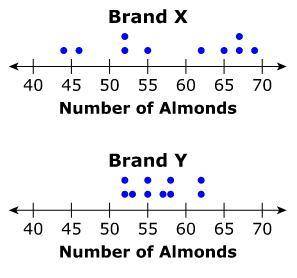I will give out brainliest!
Alexis chose a random sample of 10 jars of almonds from each of tw...

Mathematics, 24.04.2020 21:46, giiffnlojd
I will give out brainliest!
Alexis chose a random sample of 10 jars of almonds from each of two different brands, X and Y. Each jar in the sample was the same size. She counted the number of almonds in each jar. Her results are shown in the plots.
dot plot of almonds in bag
Based on the plots, which statement best compares the number of almonds in the jars from the two brands?
Question 2 options:
The number of almonds in jars from Brand X tends to be greater and more consistent than those from Brand Y.
The number of almonds in jars from Brand X tends to be greater and less consistent than those from Brand Y.
The number of almonds in jars from Brand X tends to be fewer and more consistent than those from Brand Y.
The number of almonds in jars from Brand X tends to be fewer and less consistent than those from Brand Y.
The Graph:


Answers: 2
Other questions on the subject: Mathematics

Mathematics, 21.06.2019 17:00, SillyEve
In tossing one coin 10 times, what are your chances for tossing a head? a tail? 2. in tossing one coin 100 times, what are your chances for tossing a head? a tail? 3. in tossing one coin 200 times, what are your chances for tossing a head? a tail? deviation = ((absolute value of the difference between expected heads and observed heads) + (absolute value of the difference between expected tails and observed tails)) divided by total number of tosses. this value should always be positive. 4. what is the deviation for 10 tosses? 5. what is the deviation for the 100 tosses? 6. what is the deviation for 200 tosses? 7. how does increasing the total number of coin tosses from 10 to 100 affect the deviation? 8. how does increasing the total number of tosses from 100 to 200 affect the deviation? 9. what two important probability principles were established in this exercise? 10. the percent of occurrence is the obtained results divided by the total tosses and multiplied by 100%. toss the coins 100 times and record your results. calculate the percent occurrence for each combination. percent head-head occurrence: percent tail-tail occurrence: percent head-tail occurrence:
Answers: 3

Mathematics, 22.06.2019 00:30, ashled7789
Which number can each term of the equation be multiplied by to eliminate the decimals before solving? 5.6j- 0.12=4+1.1j
Answers: 3


Mathematics, 22.06.2019 01:00, sierraseideman1023
X^2/100+y^2/25=1 the length of the major axis is: a)5 b)10 c)20
Answers: 3
Do you know the correct answer?
Questions in other subjects:


History, 09.07.2019 23:30

Mathematics, 09.07.2019 23:30





Mathematics, 09.07.2019 23:30

Physics, 09.07.2019 23:30

English, 09.07.2019 23:30






